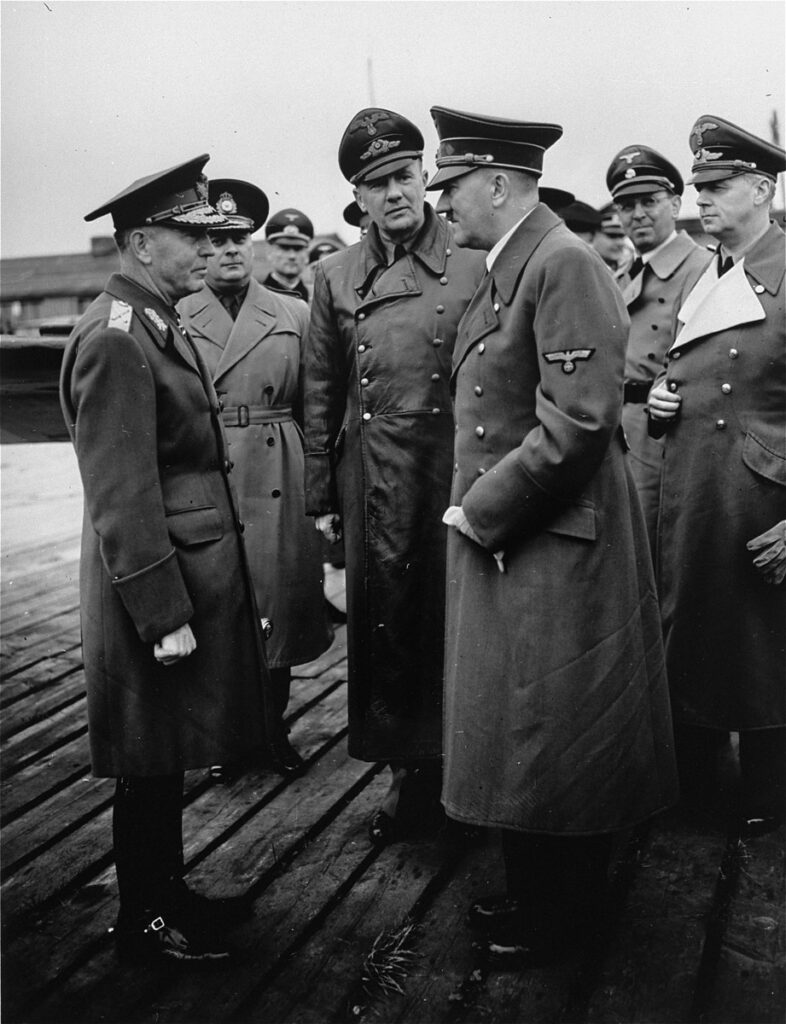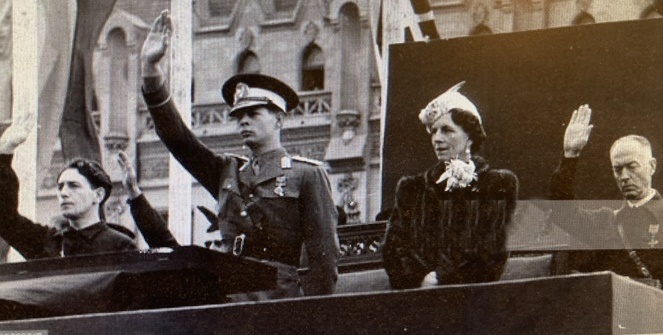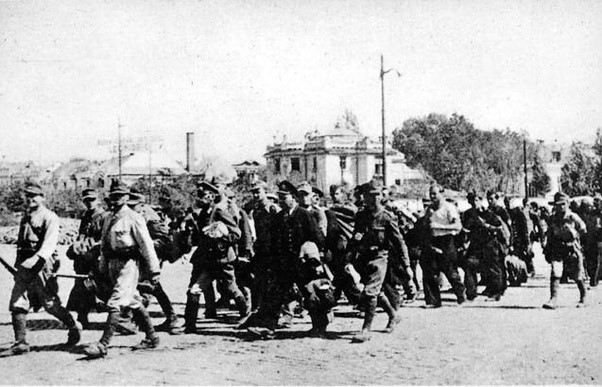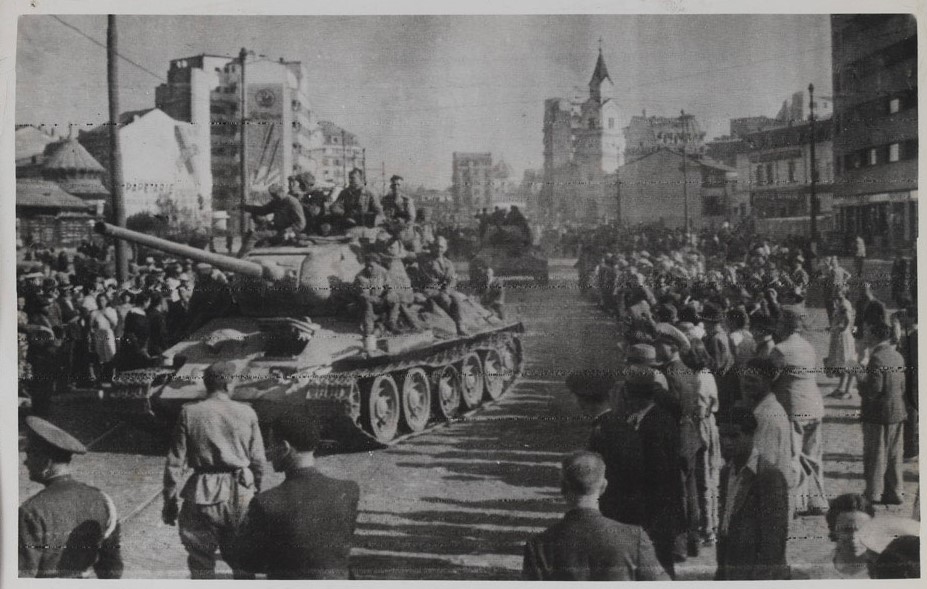The latest in a series of occasional articles, by Andy Ford (Warrington South Labour member) marking 80-year anniversaries of events in Soviet history in World War Two.
[Featured photo shows the Soviet Red Army in Bucharest – 31 August 1944]
********
In August 1944, Romania, which had been a German satellite since 1940, dramatically changed sides and joined the Allied Powers. It was another huge blow to Hitler and his ‘Thousand Year Reich’.
Palace coup
The switch was through a palace coup engineered by the young King, Michael, and his contacts in the military. The military dictator of Romania, Ion Antonescu, was arrested and the German ambassador was informed that diplomatic, military and economic relations between Romania and Germany were at an end. At 22.00 hours on August 23rd, 1944 Romanian radio announced that Romanian troops were no longer to offer resistance to the Red Army and that the Germans had been told to leave. 400,000 German soldiers in Romania risked encirclement and capture.
Initially, the King and his clique tried to secure a peaceful withdrawal of German troops from the country, but Hitler was having none of it. He instructed German troops manning the huge anti-aircraft defences around the oil wells of Ploesti, Nazi Germany’s only significant source of oil, to move towards the capital, Bucharest. Meanwhile, German planes based at Ploesti and Otopeni bombed the capital.
He also ordered his elite commando, Otto Skorzeny, who had freed Mussolini, to rescue the ousted dictator, Antonescu. Other commandoes were despatched to Romanian airfields to destroy the aircraft there. The air force was the one modern component of Romania’s armed forces.

with Hitler.
All these operations failed: Antonescu could not be located, and ended up being handed over to the Red Army; the Special Forces were defeated by Romanian paratroopers, and the attack on Bucharest ended with German surrender on August 28th. It has been described as the greatest failure of Nazi Special Forces in the entire war. The Red Army entered Bucharest on the 30th August, while the Romanian army was despatched to retake Transylvania from the Hungarian allies of Nazi Germany.
The British newspaper Socialist Appeal of September 1944 drily noted that King Michael’s statement that Romania “Has returned to her national traditions” was quite true. In WW1, Romania began as an ally of Germany and then switched sides; now history had repeated itself! The article pointed out how the Stalinists and the Allies had welcomed the dictatorial Romanian regime into their ranks, the same regime, except for the figurehead, that had allied with Hitler, thus revealing the pretence that this was a “war against fascism”.
“Gangster dictatorship”
As the Socialist Appeal explained,
“Michael was king while the gangster dictatorship persecuted the Jews, murdered trade unionists and smashed the workers organisations, and cruelly exploited the peasants of Romania for the benefit of the landowners”.
The newspaper of Trotskyists in the USA, Militant, of 2 September 1944 pointed out that it was the new ‘democratic’ King Michael who had declared, “Romanians! The dictatorship has ended” but he had been,
“…a puppet to the Nazis, who went to Odessa after Soviet Black Sea port was captured by German and Romanian troops – there to congratulate the despoilers of Soviet territory on their handiwork. He proclaimed Odessa “forever Romanian” as the centre of that conquered Russian territory which his government in Bucharest named ‘Transdniestria’.”
Some democrat and anti-Nazi!

The King’s first decrees were an amnesty for all political crimes since 1918 and the political closure of Romania’s concentration camps. Romania’s communists were therefore set at liberty. Ironically, the future leaders of the Romanian Communist Party mainly came from the concentration camps, as Stalin had executed almost the entire exiled leadership in 1937-38. Stalin probably killed more Romanian communists than Antonescu!
As a cover for his regime, the King invited one representative from each of the previously banned political parties – the Peasant Party, the Liberals, the Social Democrats, and the Communist Party – to join the cabinet as ‘ministers without portfolio’. The key ministries of defence, the interior and finance however were filled by generals and admirals drawn from the class of nobles.
Stalin’s policy in Romania
The whole saga also revealed the hypocrisy of the Stalinist regime, as:
“While pretending that the ordinary German workers and peasants are responsible for the crimes of the Nazis, and holding them responsible for their misdeeds, Stalin is quite prepared to come to terms with the Romanian gentry genuinely responsible for similar atrocities and crimes.”
The one thing Stalin did not do was to issue a call the Romanian workers to seize the factories, or the peasants to seize the landed estates. In fact, as part of the deal, Stalin guaranteed no changes in the political and social conditions in Romania.
In the north western corner of Romania, which was the first to be occupied by the Red Army, foreign correspondents reported that the old reactionary mayors and officials had been confirmed in post by the Stalinists, and that where rebellious workers and peasants had removed them, they were being reinstated. Even worse,
“Local laws, including those with anti-Semitic provisions, are left unchanged … This attitude is applied even to the Rumanian act outlawing the Communist Party, which remains on the books.”
[Quoted in ‘Stalin’s Rumanian policy lays bare his plans to strangle the European revolution’, in Fourth International, July 1944 see link here]
Romania’s backwardness
Romania was actually a country crying out for fundamental change. Slavery was only abolished in 1856, and the legal status of serfdom in 1864. It was still semi-feudal, with noblemen, or counts, holding huge estates, on which peasants toiled for a bare subsistence.
This affected the efficiency of the Romanian Army, with the officers of the army being drawn from the ranks of the nobles and the soldiers conscripted from the peasantry. The officers slept in separate accommodation and even had their own food. Add to this the woeful under-equipment of the army in terms of trucks, tanks and anti-tank weapons and it was no wonder that the Romanian Army had a tendency to fold in the face of attack by the Red Army.

near Bucharest – 1944
Nevertheless, Romania had fielded an army of one million men, and supplied more troops for the invasion of the USSR than all the other allies of Nazi Germany combined. The loss of two Romanian armies at Stalingrad had been a devastating blow, and German arrogance towards their Romanian allies during the loss of Crimea, where they often abandoned Romanian units to their fate, had fatally undermined the commitment of the Romanian military to their ill-fated alliance with the Nazis.
Germany had also stripped Romania of Transylvania in 1940 by awarding the region to Hungary, and secretly agreed the transfer of Bessarabia (Moldova) to the USSR under the Molotov-Ribbentrop pact of 1939. Added to which the Germans quite often did not pay for Romanian oil, or else paid in kind.
But the Romanian generals were far from being simply victims or dupes of the Nazis. They had participated in many round ups and massacres of Jews and partisans, and are estimated to have been involved in the murder of around 200,000 Jews in the occupied territories, even though many Jewish people resident in Romania itself did survive the war.
By 1944 Romania was supplying about 40% of Nazi Germany’s oil, which was essential for the Luftwaffe, the U-boats and the armoured divisions. It had 900,000 men the field and was holding hundreds of miles of the frontline.
The defection of this German ally tore a huge hole in the Nazi’s Balkan front. An almost immediate consequence was the defection of Bulgaria from the Axis, followed by intensified resistance in Greece and a boost to Tito’s partisans in Yugoslavia who now shared a border with a friendly state.



